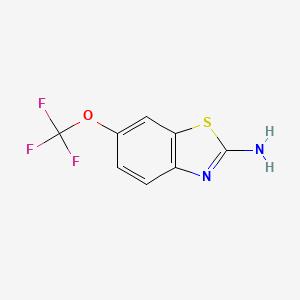Drug Information
Drug (ID: DG00592) and It's Reported Resistant Information
| Name |
Riluzole
|
||||
|---|---|---|---|---|---|
| Synonyms |
Riluzole; 1744-22-5; Rilutek; 2-Amino-6-(trifluoromethoxy)benzothiazole; 6-(trifluoromethoxy)benzo[d]thiazol-2-amine; 6-(trifluoromethoxy)-1,3-benzothiazol-2-amine; RP-54274; 2-amino-6-trifluoromethoxybenzothiazole; 2-amino-6-(trifluoromethoxy)benzo[d]thiazole; 2-Benzothiazolamine, 6-(trifluoromethoxy)-; PK-26124; RP 54274; C8H5F3N2OS; UNII-7LJ087RS6F; Riluzole (Rilutek); Amino-2 trifluoromethoxy-6 benzothiazole; MLS000069369; 6-Trifluoromethoxy-benzothiazol-2-ylamine; 2-Benzothiazolamine,6-(trifluoromethoxy)-; 2-Amino-6-(trifluoromethoxy)-benzothiazole; CHEMBL744; SMR000058231; 7LJ087RS6F; CHEBI:8863; Riluzol; 2-amino-6-(trifluoromethoxy)-1,3-benzothiazole; BENZOTHIAZOLE, 2-AMINO-6-TRIFLUOROMETHOXY-; MFCD00210213; NSC-753433; NSC-759823; NCGC00015882-09; Riluzolum; Riluzol [INN-Spanish]; Riluzolum [INN-Latin]; DSSTox_CID_25192; DSSTox_RID_80739; DSSTox_GSID_45192; Rilutek (TN); CAS-1744-22-5; Amino-2 trifluoromethoxy-6 benzothiazole [French]; Tiglutik; 2-amino-6-(trifluoromethoxyl)benzothiazole; Riluzole, solid; Riluzole [USAN:USP:INN:BAN]; Riluzole- Bio-X; BF-37; ALBB-006046; Prestwick-03A08; 6-(trifluoromethoxy)-2-benzothiazolamine; Tocris-0768; PK 26124; 6-trifluoromethoxybenzothiazole-2-yl-amine; Opera_ID_548; Lopac-R-116; Riluzole-13C-15N2; Prestwick0_000167; Prestwick1_000167; Prestwick2_000167; Prestwick3_000167; Spectrum2_000550; Biomol-NT_000245; cid_5070; Riluzole (JAN/USP/INN); Lopac0_001064; SCHEMBL78905; BSPBio_000033; BIDD:GT0055; SPBio_000599; SPBio_001954; BPBio1_000037; BPBio1_000837; GTPL2326; ZINC6481; DTXSID3045192; BDBM30705; Bio1_000416; Bio1_000905; Bio1_001394; HMS1773G08; HMS2089O19; HMS2094G07; HMS2233E14; HMS3263E10; HMS3371A09; HMS3657E13; Pharmakon1600-01505348; AMY14166; BCP02142; BHV-0223; HY-B0211; Riluzole - CAS 1744-22-5; Tiglutik (thickened oral suspension); Tox21_110252; Tox21_501064; AC-730; BBL013272; CCG-39528; NSC753433; NSC759823; s1614; STK503686; AKOS000265071; Tox21_110252_1; DB00740; KS-5231; LP01064; MCULE-9362288181; NSC 753433; NSC 759823; SDCCGSBI-0051034.P003; 2-amino-6-trifluoromethoxy-benzothiazole; 6-(trifluoromethoxy)benzothiazol-2-amine; 6-trifluoromethoxy-2-amino-benzothiazole; NCGC00015882-01; NCGC00015882-02; NCGC00015882-03; NCGC00015882-04; NCGC00015882-05; NCGC00015882-06; NCGC00015882-07; NCGC00015882-08; NCGC00015882-10; NCGC00015882-11; NCGC00015882-12; NCGC00015882-13; NCGC00015882-15; NCGC00015882-28; NCGC00023141-02; NCGC00023141-04; NCGC00023141-05; NCGC00023141-06; NCGC00261749-01; 6-(trifluoromethoxy)-2-aminobenzothiazole; 6-trifluoromethoxybenzo[d]thiazol-2-amine; BR164340; H090; SBI-0051034.P002; 2-Amino-6-(Trifluoromethoxy) Benzothiazole; 6-(Trifluoromethoxy)-2-amino-benzothiazole; DB-030335; EU-0101064; FT-0611194; R1174; SW196805-4; EN300-23782; 6-trifluoromethoxy-1,3-benzothiazol-2-ylamine; C07937; D00775; J10184; J10441; VU0239571-11; 744R225; Q415744; SR-01000002997-3; BRD-K21283037-001-02-5; BRD-K21283037-003-03-9; BRD-K21283037-003-06-2; F3282-0020; Z166605314; Rilutek; ; ; Rilutor; ; ; 6-(Trifluoromethoxy)-2-benzothiazolamine; Riluzole, United States Pharmacopeia (USP) Reference Standard; 2-Amino-6-(trifluoromethoxy)-1,3-benzothiazole;2-AMINO-6-(TRIFLUOROMETHOXY)BENZOTHIAZOLE
Click to Show/Hide
|
||||
| Indication |
In total 1 Indication(s)
|
||||
| Structure |

|
||||
| Drug Resistance Disease(s) |
Disease(s) with Clinically Reported Resistance for This Drug
(1 diseases)
[2]
Disease(s) with Resistance Information Discovered by Cell Line Test for This Drug
(1 diseases)
[1]
|
||||
| Target | Voltage-gated sodium channel alpha Nav1.9 (SCN11A) | SCNBA_HUMAN | [2] | ||
| Click to Show/Hide the Molecular Information and External Link(s) of This Drug | |||||
| Formula |
C8H5F3N2OS
|
||||
| IsoSMILES |
C1=CC2=C(C=C1OC(F)(F)F)SC(=N2)N
|
||||
| InChI |
1S/C8H5F3N2OS/c9-8(10,11)14-4-1-2-5-6(3-4)15-7(12)13-5/h1-3H,(H2,12,13)
|
||||
| InChIKey |
FTALBRSUTCGOEG-UHFFFAOYSA-N
|
||||
| PubChem CID | |||||
| ChEBI ID | |||||
| TTD Drug ID | |||||
| VARIDT ID | |||||
| INTEDE ID | |||||
| DrugBank ID | |||||
Type(s) of Resistant Mechanism of This Drug
Drug Resistance Data Categorized by Their Corresponding Diseases
ICD-08: Nervous system diseases
| Drug Resistance Data Categorized by Their Corresponding Mechanisms | ||||
|
|
||||
| Key Molecule: Multidrug resistance protein 1 (ABCB1) | [1] | |||
| Molecule Alteration | Expression | Up-regulation |
||
| Resistant Disease | Amyotrophic lateral sclerosis [ICD-11: 8B60.0] | |||
| Experimental Note | Revealed Based on the Cell Line Data | |||
| In Vitro Model | bEND.3 cells | Brain | Homo sapiens (Human) | CVCL_0170 |
| C8D1A cells | Colon | Mus musculus (Mouse) | CVCL_6379 | |
| Experiment for Molecule Alteration |
Western blotting analysis | |||
| Experiment for Drug Resistance |
High-performance liquid chromatography | |||
| Mechanism Description | Riluzole is moderately effective for ALS patients and prolongs survival by only three months. According to previous studies, increased P-gp transporter activity and expression are induced by ALS. As riluzole is a substrate of P-gp, the inductions potentially limit the brain distribution of riluzole and further promote drug resistance in the later stage of ALS disease. | |||
| Drug Sensitivity Data Categorized by Their Corresponding Mechanisms | ||||
|
|
||||
| Key Molecule: Multidrug resistance protein 1 (ABCB1) | [1] | |||
| Molecule Alteration | Expression | Down-regulation |
||
| Sensitive Disease | Amyotrophic lateral sclerosis [ICD-11: 8B60.0] | |||
| Experimental Note | Revealed Based on the Cell Line Data | |||
| In Vitro Model | bEND.3 cells | Brain | Homo sapiens (Human) | CVCL_0170 |
| C8D1A cells | Colon | Mus musculus (Mouse) | CVCL_6379 | |
| Experiment for Molecule Alteration |
Western blotting analysis | |||
| Experiment for Drug Resistance |
High-performance liquid chromatography | |||
| Mechanism Description | BEND.3 Cells were treated with riluzole and verapamil liposomes at different doses and time durations to determine the inhibitory levels of P-gp. In the buffer control treatment, the expression of P-gp was noted as a baseline level (100%). After the exposure to 5, 10, 20, 30, and 40 ug/ml cocktail liposomes for 48 h, bEND.3 cells resulted in a distinct decrease of P-gp expression with 93.0 plus or minus 5.2%, 85.8 plus or minus 4.7%, 50.3 plus or minus 5.6% 26.2 plus or minus 5.1%, and 20.8 plus or minus 4.9% of the baseline level, respectively. The extent of the decrease was linearly dependent on the concentration of verapamil in formulations (5 to 30 ug/ml), while inhibited levels of P-gp by 30 ug/ml and 40 ug/ml of verapamil cocktail liposome were not significantly different. | |||
| Drug Resistance Data Categorized by Their Corresponding Mechanisms | ||||
|
|
||||
| Key Molecule: Multidrug resistance protein 1 (ABCB1) | [2] | |||
| Molecule Alteration | Expression | Up-regulation |
||
| Resistant Disease | Spinal cord injury [ICD-11: 8C21.0] | |||
| Experimental Note | Identified from the Human Clinical Data | |||
| In Vivo Model | Abcb1a Knockout rats model | Mus musculus | ||
| Experiment for Molecule Alteration |
Western blotting assay | |||
| Experiment for Drug Resistance |
High performance liquid chromatography assay | |||
| Mechanism Description | Riluzole spinal cord disposition was significantly higher in knockout rats than in WT rats at 10 days post-spinal cord injury (p=0.019), confirming that Pgp plays a critical role in diminishing spinal cord riluzole disposition following spinal cord injury. | |||
References
If you find any error in data or bug in web service, please kindly report it to Dr. Sun and Dr. Zhang.
